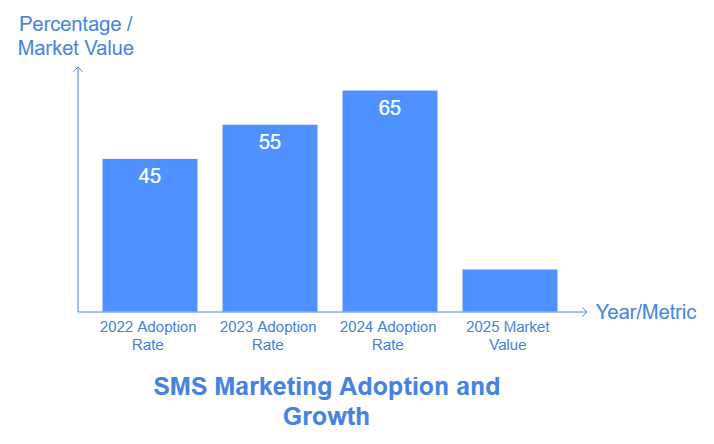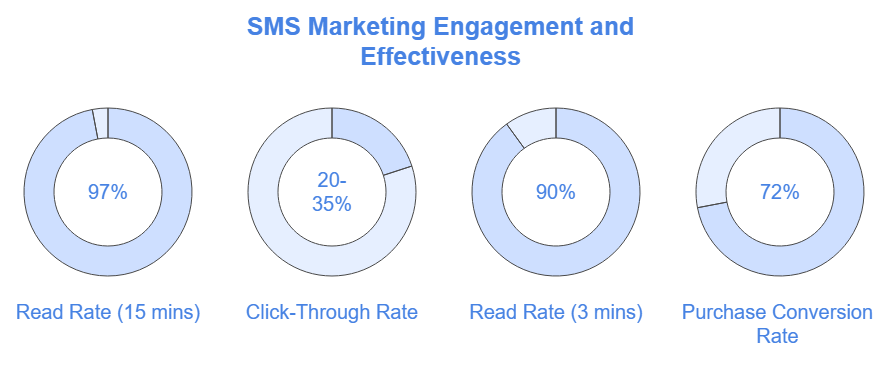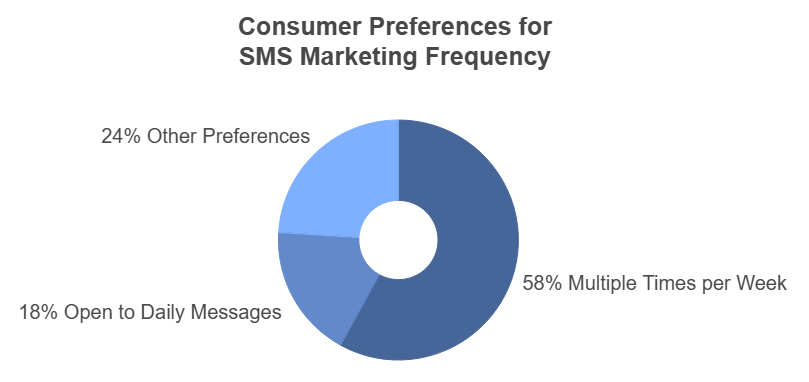SMS (Short Message Service) marketing has emerged as a powerful and effective channel for businesses to reach and engage customers.
As smartphone usage continues to grow globally, SMS provides a direct and immediate way for brands to communicate with their audience.
This article examines the latest SMS marketing statistics, trends, and best practices to help businesses optimize their mobile marketing strategies in 2024 and beyond.
Key SMS Marketing Statistics
Adoption and Market Growth
- The SMS marketing market in the United States is expected to reach $12.6 billion by 2025, with a compound annual growth rate (CAGR) of 20.3%[2].
- Approximately 65% of businesses across various industries have adopted SMS in their overall marketing strategies in 2024, up from 55% in 2023 and 45% in 2022[4].
- 86% of business owners and marketing managers used SMS marketing in 2023[2].

Engagement and Effectiveness
- SMS messages have an average 97% read rate within 15 minutes of delivery[3].
- The average click-through rate for SMS campaigns is 20-35%[3].
- 90% of text messages are read within three minutes of receipt[2].
- 72% of people have made a purchase after receiving a text from a brand. This number is slightly higher in Europe at 74% and lower in Asia-Pacific at 69%[1].

Consumer Preferences
- 91% of consumers are interested in signing up for texts from brands[3].
- 81.2% of consumers are opted in to at least one brand’s text message marketing program[3].
- 58% of consumers want to receive texts from brands multiple times per week, while 18% are open to daily marketing text messages[3].

Impact on Sales and Revenue
- 63% of consumers who subscribe to at least one brand’s SMS marketing program have made a purchase from a text message within the last three months[3].
- Nearly 96% of marketers using text messaging say it’s helped them drive more revenue[3].
- 86% of respondents made 2+ purchases in the last year from SMS messages, up from 55% in 2022[1].
Industry-Specific SMS Marketing Statistics
Different industries have varying levels of SMS marketing adoption and effectiveness:
- Retail & E-commerce:
- 80-85% of retailers use text messages to communicate with customers[4].
- Average click-through rate of 36% for SMS campaigns[4].
- Healthcare:
- 98% open rate for appointment reminders sent via SMS[4].
- Finance:
- 57% of customers prefer SMS for fraud alerts[4].
- Hospitality:
- 45% increase in bookings when using SMS marketing[4].
Comparison with Other Marketing Channels
SMS marketing outperforms many other digital marketing channels in terms of engagement:
- Open rates: SMS (97%) vs. Email (20-30%) vs. Social media post reach (5.5% on Facebook)[4].
- Click-through rates: SMS (20-35%) vs. Email (2.5%) vs. Display ads (0.1%)[4].
- Response time: 90% of SMS messages are read within 3 minutes, compared to 23% of emails opened within an hour[4].
Geographic Variations
SMS marketing effectiveness varies across regions:
- North America: 95% open rate
- Europe: 88% open rate
- Asia-Pacific: 98% open rate
- Africa: 97% open rate[4]
Demographic Insights
Different age groups show varying engagement levels with SMS marketing:
- Gen Z (18-24): 83% prefer SMS for brand communications
- Millennials (25-40): 75% find SMS reminders helpful
- Gen X (41-56): 63% opt-in for SMS promotions
- Baby Boomers (57-75): 47% engage with SMS marketing[4]
Cost-Effectiveness and ROI
SMS marketing demonstrates strong return on investment compared to other channels:
- Average ROI for SMS marketing campaigns: 500%
- Cost per acquisition via SMS: $5-10, compared to $15-20 for email and $50-60 for paid social media ads[4]
Best Practices for SMS Marketing
Based on the latest statistics, here are some data-driven best practices for SMS marketing:
- Message Length: Keep messages to 160 characters or less for optimal engagement[4].
- Timing: Send messages between 10 AM and 1 PM on weekdays for the best response rates[4].
- Frequency: Aim for 2-4 messages per month to maintain engagement without overwhelming subscribers[4].
- Personalization: Incorporate personalized elements to increase engagement by up to 26%[4].
- Opt-in Incentives: Offer dollar-off discounts as the top preferred incentive for sign-ups, followed by percentage-off discounts and free gifts with purchase[3].
- Content Mix: Include a variety of message types, with incentives/coupons and loyalty benefits ranking as the top two types of marketing messages consumers are interested in receiving[3].
- Multichannel Integration: Use SMS in conjunction with email marketing, as 35% of people find receiving the same message via email and SMS to be very helpful[1].
Compliance and Regulation
As SMS marketing grows, it’s crucial to adhere to regulations across different regions:
- USA: The Telephone Consumer Protection Act (TCPA) requires explicit opt-in and easy opt-out options.
- EU: The General Data Protection Regulation (GDPR) mandates clear consent and data protection measures.
- Canada: The Canadian Anti-Spam Legislation (CASL) enforces strict anti-spam rules for electronic messages.
- Australia: The Spam Act 2003 requires consent and sender identification[4].
Future Trends in SMS Marketing
Several emerging trends are shaping the future of SMS marketing:
- AI-powered Personalization: Expected to increase conversions by 30% through more targeted and relevant messaging[4].
- Rich Communication Services (RCS): Predicted to reach 74% of smartphones by 2025, offering enhanced messaging capabilities[4].
- Chatbots: Projected to handle 75% of customer interactions via SMS by 2025, improving response times and customer service[4].
- 5G Technology: Expected to enhance SMS marketing capabilities with rich media content and faster delivery[4].
Case Studies
Real-world examples demonstrate the effectiveness of SMS marketing across industries:
- Retail: Target increased Black Friday sales by 14% using personalized SMS campaigns.
- Food Service: Domino’s Pizza boosted order volume by 33% through an SMS-based loyalty program.
- Hospitality: Airbnb reduced booking cancellations by 26% with timely SMS reminders.
- Finance: A regional bank increased loan applications by 18% using targeted SMS promotions[4].
Conclusion
SMS marketing continues to prove its value as a highly effective, widely adopted, and rapidly growing marketing channel. With its unparalleled open rates, strong engagement metrics, and proven impact on sales, SMS marketing presents a significant opportunity for businesses across various industries.
Key takeaways for businesses looking to leverage SMS marketing in 2024 and beyond:
- Prioritize SMS as a core component of your marketing strategy, given its high engagement rates and consumer preference.
- Focus on personalization and relevance to maximize the impact of your SMS campaigns.
- Integrate SMS with other marketing channels, particularly email, for a cohesive multichannel approach.
- Stay compliant with regional regulations to build trust and avoid legal issues.
- Experiment with emerging technologies like AI and RCS to stay ahead of the curve.
- Regularly analyze performance metrics and adjust strategies based on industry benchmarks and best practices.
By leveraging these insights and staying attuned to evolving trends, businesses can harness the full potential of SMS marketing to drive engagement, loyalty, and revenue growth in an increasingly mobile-first world.
Sources
[1] Klaviyo. (2024). 100+ SMS & Text Marketing Statistics to Know in 2024. https://www.klaviyo.com/blog/sms-stats
[2] Sixth City Marketing. (2024). 85+ SMS & Mobile Marketing Statistics for 2024. https://www.sixthcitymarketing.com/mobile-marketing-statistics/
[3] Attentive. (2022). SMS Marketing by the Numbers: 30+ Texting Statistics You Need to Know. https://www.attentive.com/blog/texting-statistics
[4] TextDrip. (2024). SMS Marketing Statistics 2024: Key Trends and Insights for Effective Marketing Strategies. https://textdrip.com/blog/sms-marketing-statistics
Citations: [1] https://www.klaviyo.com/blog/sms-stats [2] https://www.sixthcitymarketing.com/mobile-marketing-statistics/ [3] https://www.attentive.com/blog/texting-statistics [4] https://textdrip.com/blog/sms-marketing-statistics [5] https://www.smscountry.com/blog/sms-marketing-statistics/ [6] https://www.sender.net/blog/sms-marketing-statistics/ [7] https://luisazhou.com/blog/sms-marketing-statistics/ [8] https://adamconnell.me/sms-marketing-statistics/
